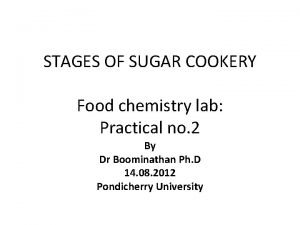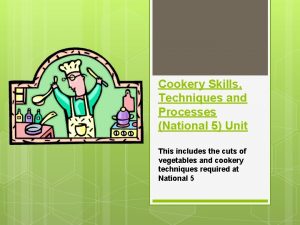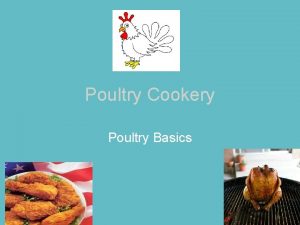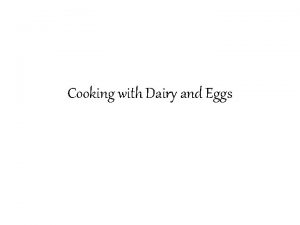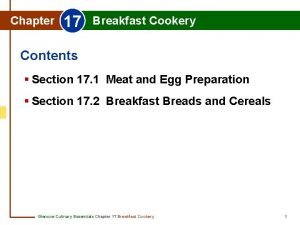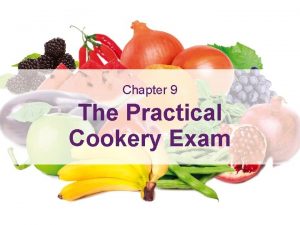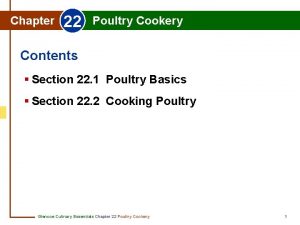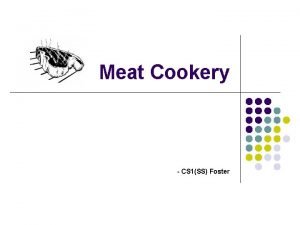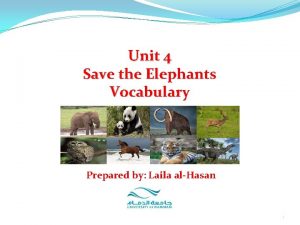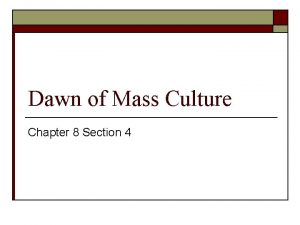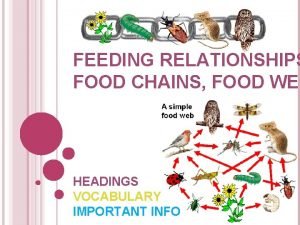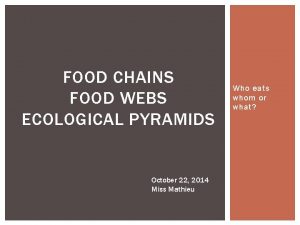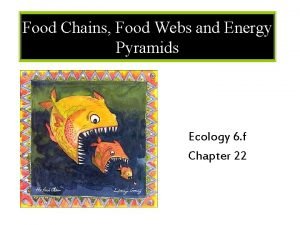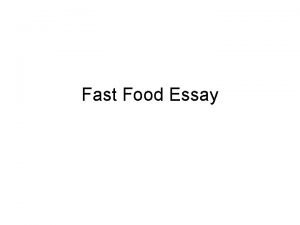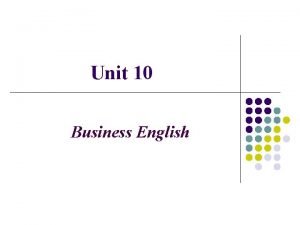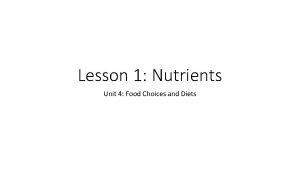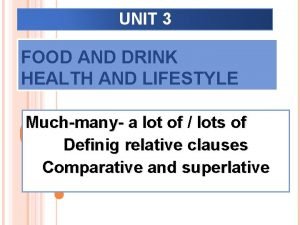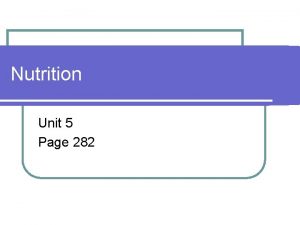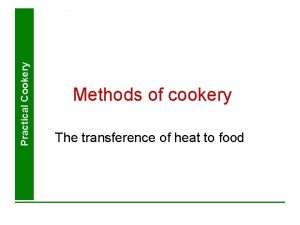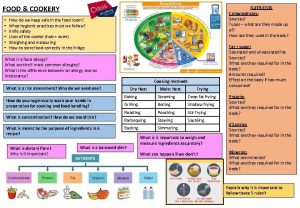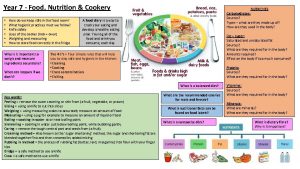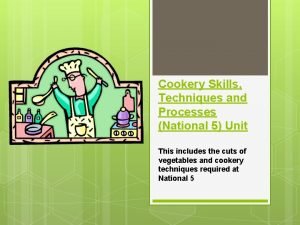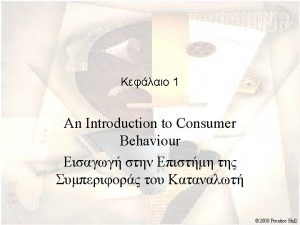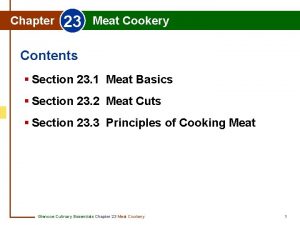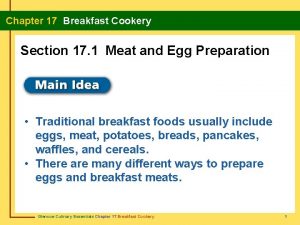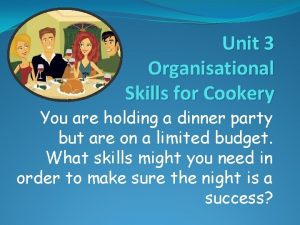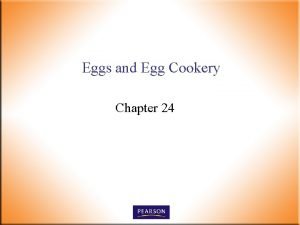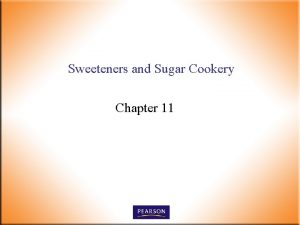Unit 8 Cookery Food and Culture Section I




































































- Slides: 68

Unit 8 Cookery, Food and Culture Section I Listening and Conversation Section II Reading Comprehension Section III Writing and Translating back

Section I Listening and Conversation back

Section I Listening and Conversation Part I Leading in Part II Putting in use Part III Further Practice Part IV Aptitude Test and Guidance back

Part I Leading in 1、Pre-class Work 2、Revision 3、Warming up for the new class: back

1. Pre-class Work • Collect some food recipes and the words about cookery spices and food back

2. Revision • Check the answers to the homework of the previous class back

3. Warming up for the new class Reading and acting out • Present your collections; • Put the collections into a data bank; • Present new materials back

Cookery Methods fry boil deep fry stew bake, roast steam stir-fry braise grill 煎 煮 炸 炖 烤 蒸 炒 红烧 烧烤 Spices oil salt soy source vinegar chili pepper curry cooking wine starch 油 盐 酱油 醋 干辣椒 胡椒 咖喱 料酒 淀粉 next

Sample 1 Yogurt IINGREDIENTS: 1) a pack of milk 2) a little yogurt INSTRUCTIONS: 1) Heat milk and boil for one minute. 2) Allow it to cool to about 40℃. 3) Add a little YOGURT as starter to it. 4) Pour the mixture into little pots. 5) Leave them in a warm place OVERNIGHT! 6) Put the pots into the fridge to cool and make them tastier. 7) Serve with brown sugar or honey. next

Sample 2 Almond Ice-cream INGREDIENTS INSTRUCTIONS 1) a one-liter package of good 1) Set the inc-cream out and leave at room quality commercial ice-cream temperature for a short time to soften it. 2) Don’t let it get too soft. 2) two or three tablespoons 3) Stir in the honey. of liquid honey 4) (Note: The honey will not blend in completely. ) 3) four tablespoons of brandy 5) Add brandy and stir till it is well blended. 6) Stir in almonds. 4) a generous handful of well 7) Put into the freezer for three hours till it is toasted almonds solid. 8) Serve in small coffee cups. back

Part II Putting in use 1. Dividing the students into groups 2. Practicing l Work in groups and practice sample dialogues 1 How to Make Your Own Yogurt? and dialogue 2 How to Make Almond Ice-cream? 3. Acting out l work in groups to 1) understand the short dialogues on Page 124 of the Textbook 2) to act out back

Part III Further Practice 1. Practicing and Furthering 2. Commenting 3. Completing 4. Responding back

1. Practicing and Furthering • Each group to choose one of the situations to 1) further the dialogue 2) act out before the class. back

2. Commenting Make comments on the performance and the appropriateness of their English; Summarize this part. back

3. Completing • Work in groups to complete by filling in the blanks on Page 125 of the Textbook (Exercises 1 and 3). back

4. Responding • Practice Exercise 2 on Page 125 of the Textbook orally. • Teacher offers the situation in Chinese, the students give the English equivalent. the whole class work together. back

The script for the dialogue • You: 对了,简。咱们今天学习包春卷怎么样?这是中国的传 统食品。 • Jean: Great! I like spring rolls very much. Are they difficult to learn? • You: 不太难。我们可以从商店购买现成的春卷皮。 • Jean: Good. How about the fillings? • You: 哦,我们可以用碎肉和虾自己做馅。 • Jean: Hmmm, The fillings smells good. • You: 现在让我们把春卷馅这样包到春卷皮里。看!很容易吧 ? • Jean: Let me have a try. Oh, mine doesn’t look as good as yours. • You: 没关系。下一步就是把春卷放到油里炸,直到春卷看上 去金黄酥脆。 • Jean: Oh, they must be delicious. I can’t wait to have one. back

Part IV Aptitude Test and Guidance 1. Match after you listen 2. Judge after you listen 3. Respond you listen 4. Self-assessment and Teacher’s Guidance 5. Assignment back

1. Match after you listen • Distribute a diagram to each of the students; • Listen to a dialogue; • Match the information in Column A with the choices in Column B. back

2. Judge after you listen • Do the multiple choices to each of the questions are given on the blackboard • Listen to a dialogue • Making a choice from A, B, C or D. back

3. Respond you listen • Listen to a dialogue and then answer the teacher’s questions. back

4. Self-assessment and Teacher’s Guidance • • Checking the answers to 1 and 2; Teacher’s brief explanations; Scoring your own paper ; Handing in the paper. back

5. Assignment • • • Workbook P 105— 1 -6 Read fluently the passage on page 133 of your Textbook and try to understand it as possible as you can by using a dictionary. Recite Practical Sentences for Tourism from 50 to 56 and Passage 8. back

Section II Reading Comprehension back

Section II Reading Comprehension Part III Part IV Leading in Comprehension and Practicing Further Practice Aptitude Test and Guidance back

Part I Leading in 1. Revision 2. Warming up for the new class back

1. Revision 1. Recite the seven practical sentences for tourism and the others repeat; 2. Answer questions according to Passage 5 for tourism. back

2. Warming up for the new class • Work in groups of four to talk about the cookery of their favorite food. back

Part II Comprehension and Practicing 1. Checking and Explaining 2. commenting 3. Retelling back

1. Checking and Explaining 1) Say true or false according to the passage on page 133 of the Textbook. 2) Answer questions in details according to the passage on page 133 of the Textbook, at the same time explaining some language points. 3) Possible difficult words, phrases and sentences. back

difficult words, sentences vary v. be different, change 不同,变换 e. g. The price of vegetables vary with the seasons. The climate varies from area to area. source n. starting point, place from which something comes or is got 源头,起源,根源 e. g. Where does the Yellow River have its source? The news comes from a reliable source. next

prejudice n. opinion or idea formed before one has adequate knowledge偏见 e. g. Many people have a prejudice against modern jazz. appreciate v. understand enjoy, put a high value on珍惜,懂得,喜欢 e. g. They appreciated the opportunity to apply the knowledge to practice. regard v. consider, think of认为,被看成是 e. g. He is regarded as a hero by the people in his country. contribute v. join with others in giving help for a common cause贡献 e. g. We want to contribute these data to this research project. next

difficult phrases sentences • (Para. 1) Studying the cuisine of different cultures is not only for fun, but also a valuable learning experience. 探究不同文化的烹调风格不但是一种乐趣。同时也 是很有价值的学习经历。 Studying the cuisine of different cultures: is a gerund phrase, used here as the subject of the sentence. The sentence can be paraphrased like this: It is not only fun but also a valuable learning experience to study the cuisine of different cultures. Doing morning exercises is not only refreshing but also a good way to keep you in shape. next

• (Para. 2) It’s customary to arrive on time for a dinner party and to bring along a bottle of wine or a small impersonal gift, such as flowers or candy. 通常出席晚宴的客人要准时到达,并带一瓶酒或 一点赴宴小礼物,例如鲜花或糖果。 It here is used as a formal subject. The actual subject is made up of two infinitive phrases to arrive on time … and to bring …, which is too lone to keep the sentence in good balance if it were put at the beginning of the sentence. e. g. It is necessary to take eight glasses of water every day and to have enough sleep. next

• (Para. 3) Sometimes a dinner is served as a buffet: people then serve themselves from a table that is set with a variety of foods. 有时聚餐是自住形式:那样的话大家就从一张放有 多种食物的大餐桌上自行取用。 The sentence can be paraphrased like this: Sometimes a dinner party may be given in the form of a buffet, at which people can take the food from a table set with different kinds of food. Sometimes the lesson is given in the form of a seminar: students will do the presentation and discuss their project together with the teacher. next

• (Para. 4) Be sure to accept a second helping if you like the food and are not full; a Canadian host will usually offer it only once. 假如你喜欢吃并且还没有吃饱,那主人第二次给 你添饭夹菜时,你一定要接受,因为加拿大主人 通常只劝菜一次。 In the imperative sentence, be sure to means “确保, 一定要“ in Chinese. The second part of the compound sentence, a Canadian host will usually offer it only once, is used to explain the reason why you should be sure to. Be sure to hand in your homework on time if you want to get a good grade: the professor is usually very strict with the students. back

2. commenting • 1) Canadian is a big country with a number of different ethnic groups and many immigrants from different cultures. In Canada it is common to see restaurants that serve food with various flavors and originated from different countries. So besides being an enjoyment, eating in Canada will also prove to be a valuable experience to learn about different cultures. • 2) A Potluck Dinner It is a kind of informal dinner party, which is usually held outdoors in a mild weather. It may also be given at one’s backyard. Relatives, neighbors and friends will enjoy the happy get-together in the open air. As a rule, everybody is supposed to contribute something, such as a dish, some drinks, some fruits, or homemade cookies or cakes to the dinner party. • 3) A Buffet Diners at a buffet will not be required to sit a t the table. They simply hold a tray and serve themselves from a table that is set with a variety of foods. Then they may move around to meet, talk, and eat with others as they like. back

3. Retelling • Read the passage again; • Retell the passage in their own words; back

Part III Further Practice 1. Simulating and translating 2. Rewriting back

1. Simulating and translating • Do exercise 6 on page 132 of the Textbook • Pay attention to the italicized parts in the English sentences and translate the Chinese sentences by simulating the structure of the English sentences back

2. Rewriting • Fill in the blanks (Excises 8 on page 135 of the textbook). • Put the instructions in order (Exercise 9 on page 135 of the textbook). back

Part IV Aptitude Test and Guidance • Translating • Assignment back

1. Translating • Remember the words, phrases and sentence structures in the passage you have learned and translate the following sentences into Chinese orally and the teacher comments. back

1、 Nobody can deny the attraction of Chinese food. People from different countries all like Chinese food and many are interested in how to cook it. 2、You are immersed in a strong cultural atmosphere in this traditional Chinese tea-house. 3、These special flavored moon-cakes have been made for our foreign friends. 4、Having jiaozi on New Year’s Eve is a Chinese custom. Making jiaozi together is a symbol of a happy family reunion. 5、Beijing Roast Duck is world-famous. It is not only good to eat; it also smells good and is good to look at. 6、We should have more fresh and green food and less junk food. back

2. Assignment • Textbook page 130 Passage 1 and Workbook page 108 1 -3. • Memorize all the words and patterns used for writing and talking about recipes. back

Section III Writing Translating and back

Section III Writing and Translating Part III Part IV Leading in Putting in use Further Practice Aptitude Test and Guidance back

Part I Leading in 1. Checking the assignment 2. Warming up for new class back

1. Checking the assignment • Check the answers to comprehension exercises on the workbook orally and comment. • Answer questions found in Passage 1. back

2. Warming up for new class • Present your collections of weather condition. • Put your collections into the data bank. back

Part II Putting in use 1. 2. 3. 4. Dividing the students into groups Presenting new materials Giving the rules for writing Simulating and writing back

Sample 1 Apple and Walnut Muffin Ingredients: Instructions: 1 egg, beaten Mix egg, orange juice, milk, 1/4 cup of orange juice apple, oil and sugar. 3/4 cup of milk Combine flour, and walnuts. 1 apple, grated Gently fold in the first mixture. 2 teaspoons of oil Spoon into lightly greased 1/4 cup of sugar muffin pans and baked at 200°c 1 cup self-raising flour for 25 minutes. 1 cup of whole meal self-raising flour 1/2 chopped walnuts next

Sample 2 Tomato with Mushrooms (Salad) Materials: 500 g tomatoes 450 g mushroom Instructions: Wash the mushrooms and stir-fry slightly in 40% heated oil. Add cooking wine, soy sauce, sugar, vegetable soup and MSG (味精). Bring to a boil, thicken with cornstarch and pour over the sliced tomatoes. back

4. Simulating and writing Translate the recipe into Chinese Fish Flavored Eggplant Materials: 250 g eggplant, 50 g chili bean sauce Preparations: • Peel and score the eggplant, cut into chunks and deep-fry till soft, remove. • Fry chili bean sauce till the flavor smells good. • Add finely chopped scallion and ginger. • Put in white sugar, soy sauce, vinegar, clear soup and the eggplants. • Thicken with cornstarch mixture. next


Part III Further Practice 1. Presenting new material 2. Simulating 3. Checking and commenting 4. Writing back

1. Presenting new material • Show students more samples. • Offer more words related to the writing of recipe. back

Sample 1 Beef Mushroom Tomato Soup Materials: 100 g fresh beef, 50 g mushrooms, and 100 g tomato Preparation: Cook the fresh beef in water till done. Add mushrooms and tomato slices. Bring to the boil. Sprinkle with ginger, salt, pepper and cooking wine. next

Sample 2 Steamed Beef with Ground Rice Material: 500 g beef and 75 g spiced ground rice Preparation: Slice the beef. Add soy sauce, hot pepper powder, mashed garlic and ground rice. Stir well. Steam the beef till soft and tender. Add seasonings. back

words for Chinese and western dishes: barbecued pork; braised bamboo shoots and mushrooms; braised beef; flavored chicken slices; fish fillet in chili sauce; ham and white gourd soup; pork meat patties; ham salad; fried prawn balls; instant boiled mutton; curry chicken soup; Irish stew; curried chicken and rice; roast turkey words for some Chinese and western snacks: dessert; pudding; pancake; sandwich; cream cake; fish and chips; hamburger; steamed roll; crisp short cake with sesame; eight-treasure rice pudding, meat pie; noodles; fried rice back

2. Simulating • Work in groups to choose from the words given to write an English recipe back

Writing Work together to write a short passage of about 100 words to tell a story or about an event related to the picture given (Page 139 of the Textbook). Some useful words and phrases have been provided to help. The passage may begin with: “Chinese food is popular in the world…” back

Part IV Aptitude Test and Guidance 1. Checking : read your passage 2. Grammatical rules concerning Subjectverb Agreement 3. Applying 4. Self-assessment and Guidance 5. Assignment back

Supply either the singular or the plural form of verb given in brackets at the end of each of the sentences. The sentences are: a. Neither my wife nor I _____ able persuade my daughter to change her mind. (be) b. One or perhaps more pages _____ missing from this book. (be) c. The value of these examinations _____ beyond estimation. (be) d. Every soldier and civilian _____ given military training. (be) e. The Prime Minister and party Leader _____ resigned office. (be) f. Finally, law and order _____ restored. (be) g. Many a teacher _____ the importance of attendance at class. (be) h. Her favorite fruit ______ grapes. (be) i. The furniture _____ the decoration very well. (match) j. The Smiths _____ to the movies quite recently. (go) k. Mathematics _____ a subject involving the study of figures, quantities, shapes, etc. (be) l. This means of communication ____ much more effective. (be) m. Three days _____ to be a short time for this task. (prove) next n. How much _____ the pair of glasses cost you? (do)

correct the errors in the following sentences. The sentences are: • • • • a. The managers of the big company is having an important meeting. b. The trees on both sides of the busy road is struggling to survive in the fume. c. Economics are a very popular subject in Western countries. d. Neither of the books are very interesting. e. Mr. Deng is the only one of us who have passed the test. f. The class is taking their seats in the conference hall. g. There has been many changes in our city in recent years. h. No one except my best friends know anything about it. i. Apple and peach is my favorite fruit. j. Bread and butter are their daily food. next

Translate the following sentences into Chinese, paying attention to the Subject-verb Agreement. The sentences are: A. There is some delicious Chinese food in the big plate. B. A century ago, the black were prohibited to enter private schools I in that country. C. Their means of living are varied. D. The rich are not always happier than the poor. E. All is well that ends well. F. None of the passengers was aware of the danger. G. Mathematics is a compulsory course in the university. H. This pair of blue jeans was bought just yesterday. back

4. Self-assessment and Guidance • 1) and 2) are printed on the paper. After the teacher checks the answers, you can score their own paper; as for 3) back

5. Assignment • Write an English recipe on your own. • Collect some English posters, notices and announcements and practice to talk about them. back
 Unit 2 food food food
Unit 2 food food food Level of nourishment in a food chain
Level of nourishment in a food chain Principles of sugar cookery
Principles of sugar cookery Cookery skills techniques and processes
Cookery skills techniques and processes Eltonian pyramid
Eltonian pyramid Popular culture example
Popular culture example Continuous culture and batch culture
Continuous culture and batch culture Difference between american and indian culture
Difference between american and indian culture Stab and stroke culture
Stab and stroke culture Folk culture and popular culture venn diagram
Folk culture and popular culture venn diagram Folk cultures are spread primarily by
Folk cultures are spread primarily by Anaerobic medium
Anaerobic medium Folk culture and popular culture venn diagram
Folk culture and popular culture venn diagram Stab culture and stroke culture
Stab culture and stroke culture Explain stab culture and stroke culture
Explain stab culture and stroke culture Surface culture deep culture and esol
Surface culture deep culture and esol Nat 5 practical cookery
Nat 5 practical cookery Poultry cookery
Poultry cookery Dry heat cooking methods
Dry heat cooking methods Principles of milk cookery
Principles of milk cookery Breakfast cookery definition
Breakfast cookery definition Practical cookery past papers
Practical cookery past papers Crosshatch marks culinary definition
Crosshatch marks culinary definition Dry heat method food examples
Dry heat method food examples Objectives in cookery
Objectives in cookery National 5 practical cookery
National 5 practical cookery Ukrainian cookery lessons
Ukrainian cookery lessons It refers to the edible flesh of an animal.
It refers to the edible flesh of an animal. Sociologists define a symbol as
Sociologists define a symbol as Batch culture vs continuous culture
Batch culture vs continuous culture Individualistic culture vs. collectivist culture
Individualistic culture vs. collectivist culture Sub culture group
Sub culture group Adaptive culture from inert culture
Adaptive culture from inert culture Characteristics of quality culture
Characteristics of quality culture Unit 10, unit 10 review tests, unit 10 general test
Unit 10, unit 10 review tests, unit 10 general test What ishorticulture
What ishorticulture Chapter 13 section 3 education and popular culture
Chapter 13 section 3 education and popular culture Chapter 13 section 3 education and popular culture
Chapter 13 section 3 education and popular culture West african society and culture section 3
West african society and culture section 3 Elephant culture and conservation unit 4
Elephant culture and conservation unit 4 Mississippian culture food
Mississippian culture food Food safety culture policy statement
Food safety culture policy statement The dawn of mass culture section 4
The dawn of mass culture section 4 Postwar america chapter 19 section 1
Postwar america chapter 19 section 1 Food web vs food chain
Food web vs food chain What do the arrows on a food web represent
What do the arrows on a food web represent Food chain and food web
Food chain and food web Difference between food chain and food web
Difference between food chain and food web Food chains, food webs and ecological pyramids
Food chains, food webs and ecological pyramids Food webs and energy pyramids
Food webs and energy pyramids Food chains food webs and energy pyramid worksheet
Food chains food webs and energy pyramid worksheet Food web desert
Food web desert Role play on healthy food and junk food
Role play on healthy food and junk food Role play on healthy food and junk food
Role play on healthy food and junk food Desert food chain
Desert food chain Name junk food
Name junk food Paragraph on fast food
Paragraph on fast food 38-2 the process of digestion
38-2 the process of digestion Section 38-1 food and nutrition
Section 38-1 food and nutrition Section 38-3 the excretory system
Section 38-3 the excretory system Unit 6 culture
Unit 6 culture Unit 10 culture
Unit 10 culture Partial section view
Partial section view Work and energy section 2 describing energy
Work and energy section 2 describing energy Unit 5 food and entertaining
Unit 5 food and entertaining Food and nutrition unit 4
Food and nutrition unit 4 Food and nutrition unit 4
Food and nutrition unit 4 Unit 3 food
Unit 3 food Food and nutrition unit 5
Food and nutrition unit 5


